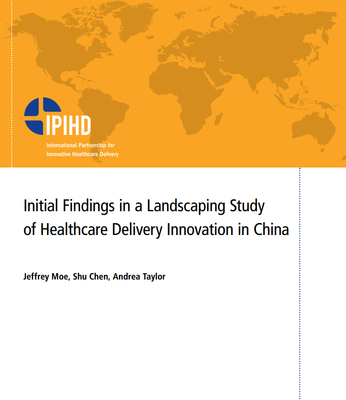IPIHD, a non-profit that works with a select group of innovative global health entrepreneurs, regularly receives applications from organizations all around the world interested in joining our network. In our first two years, we didn’t receive even one application from an organization in China. This absence of activity attracted our attention and so we started asking others involved in global health care innovation what they were seeing in China. We discovered that our partners in other organizations had the same question: was healthcare innovation happening in China?
To try to get a better handle on this question, we launched a landscaping study to learn more about whether innovation was happening in China’s healthcare sector and why or why not. With the help of IPIHD graduate research assistant, Shu Chen, we searched for papers and reports about healthcare innovation in China. We also studied aspects of the policy and economic environment in China, including the scope and implementation of recent health reforms. And we sent out a call requesting information about examples of innovation, engaging as many ‘eyes on the ground’ as we could reach.
Our search uncovered 15 examples of healthcare innovation in China. We were particularly interested in models designed to increase access to quality care for disadvantaged populations and we identified several examples from the set of 15 that met this criterion. Focusing on these models, we interviewed the organizational leaders first by phone and then in person. We toured their facilities. We met their clients. And we learned more about their early experiences, their challenges, and perhaps most importantly, how they had succeeded in the China market.
Our initial analysis suggests that healthcare innovation is happening in China but is limited and difficult to find. Structural barriers in China’s healthcare ecosystem are slowing the rate of emergence and the growth of innovation, relative to other countries. In a sector that is overwhelmingly run by the government, it can be difficult for newcomers to get a foothold and navigate the regulatory requirements. Innovations that do emerge can be hard to find, in part because attracting attention as a private-sector model can lead to unwanted attention by regulators and political leaders who may feel that the model competes with public-sector healthcare delivery. The innovators that we studied often targeted the least-regulated elements of the healthcare market (such as preventive care) and/or partnered with the government, building complementary rather than competitive relationships.
Through this study, we identified several themes that provide insight into what types of healthcare innovations can succeed in China and the structural barriers to innovation growth.
Economic and demographic disparities between the eastern and western regions of China influence the design of emerging healthcare innovations. These disparities create opportunities for innovations that leverage the resources of the east to meet needs in the west. In addition, the uneven economic growth is driving migration but western migrants working informally in eastern cities often don’t qualify for government health benefits outside of their home province. This creates opportunities for the private sector to develop care models to reach this underserved population.
Recent national health care reforms are creating market gaps that may encourage innovation. However, it is early and yet to be seen how the implementation of these reforms will impact healthcare access. As these reforms are rolled out province-by-province, persistent opportunities for innovation are still being defined. Innovative models targeting the underserved are less likely to emerge in such an uncertain environment because sustainability and growth prospects, critical to the success of a new venture, are difficult to project.
Successful innovation in China often requires public-private collaboration, which can be challenging and may discourage entry of entrepreneurs into the market. Our study suggests that partnering with the public sector, and clearly demonstrating a benefit to the public health system, can help to ensure sustainability of private-sector healthcare delivery innovations. Several Chinese innovations have succeeded by identifying local political allies and aligning their model with recent policy initiatives and priorities.
It is unclear if “structural uncertainty” in the healthcare sector will fuel innovation as it has in China’s information technology sector. Loosely structured policies at differing jurisdictional levels create policy uncertainty, which can be exploited by provinces and municipalities that interpret policies differently to pursue their own local goals. While structural uncertainty introduces risk, it can also foster innovation, as it did in the IT sector, when regulations are open to interpretation and private investment works together with government investment to fuel fast growth of innovation.
Given the healthcare challenges faced by China, including meeting the needs of the world’s largest aging population, innovative models may be not only beneficial, but necessary. Our findings suggest that the government should encourage and increase support for innovators to test their ideas and enter the market. Likewise, entrepreneurs should track policy and demographic shifts to tap into opportunities to meet emerging needs.
Innovative models of healthcare delivery in China have the potential to play a transformative role in China’s healthcare reform, and to bring about results that would undoubtedly reverberate around the world as other nations search for solutions to similar challenges.
To discover more about current innovations in China, see the report by Jeffery Moe, Shu Chen, and Andrea Taylor: Initial Findings in a Landscaping Study of Healthcare Delivery Innovation in China.

